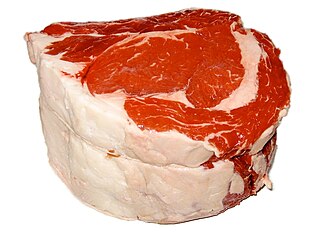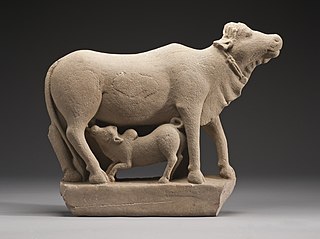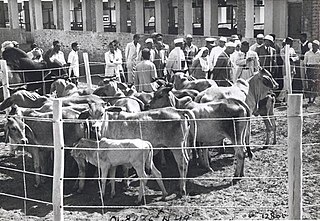
Milk is a white liquid food produced by the mammary glands of mammals. It is the primary source of nutrition for young mammals before they are able to digest solid food. Immune factors and immune-modulating components in milk contribute to milk immunity. Early-lactation milk, which is called colostrum, contains antibodies that strengthen the immune system, and thus reduces the risk of many diseases. Milk contains many nutrients, including protein and lactose.

Beef is the culinary name for meat from cattle.

Due to the multiple benefits from cattle, there are varying beliefs about cattle in societies and religions. In some regions, especially most states of India, the slaughter of cattle is prohibited and their meat may be taboo.

Dairy cattle are cattle bred for the ability to produce large quantities of milk, from which dairy products are made. Dairy cattle generally are of the species Bos taurus.

Cow dung, also known as cow pats, cow pies or cow manure, is the waste product (faeces) of bovine animal species. These species include domestic cattle ("cows"), bison ("buffalo"), yak, and water buffalo. Cow dung is the undigested residue of plant matter which has passed through the animal's gut. The resultant faecal matter is rich in minerals. Color ranges from greenish to blackish, often darkening soon after exposure to air.

Tiruvallur is a Grade I municipality and a fast developing city in the Indian state of Tamil Nadu. It is located on the banks of Coovum river about 46 km (29 mi) from downtown Chennai (Madras) and just 5 km from megacity border, in the western part of the Chennai Metropolitan Area (CMA). It is the administrative headquarters of Tiruvallur district. The city is known for the Veera Raghavar temple, one of the 108 sacred shrines of Vaishnavites. The tank festival is held at a pond near this temple. A Shiva temple near this shrine which is popular among the locals. There is also a 40-foot (12 m) tall Viswaroopa Panchamukha Hanuman temple, where the murti is made of a single green granite stone.

Basirhat is a city of West Bengal, India. It is located on the banks of the Ichamati (Ichhamati) River.
Dharampal was an Gandhian thinker. He authored The Beautiful Tree: Indigenous Indian Education in the Eighteenth Century (1983), Indian Science and Technology in the Eighteenth Century (1971) and Civil Disobedience and Indian Tradition (1971), among other seminal works, which have led to a radical reappraisal of conventional views of the cultural, scientific and technological achievements of Indian society at the eve of the establishment of Company rule in India.

Bovine spongiform encephalopathy (BSE), is an incurable and invariably fatal neurodegenerative disease of cattle. Symptoms include abnormal behavior, trouble walking, and weight loss. Later in the course of the disease the cow becomes unable to function normally. There is conflicting information about the time between infection and onset of symptoms. In 2002, the WHO suggested it to be approximately four to five years. Time from onset of symptoms to death is generally weeks to months. Spread to humans is believed to result in variant Creutzfeldt–Jakob disease (vCJD). As of 2018, a total of 231 cases of vCJD had been reported globally.
Yadav refers to a grouping of traditionally non-elite, peasant-pastoral communities or castes in India that since the 19th and 20th centuries have claimed descent from the mythological king Yadu as a part of a movement of social and political resurgence. The term Yadav now covers many traditional peasant-pastoral castes such as Ahirs of the Hindi belt and the Gavli of Maharashtra.

Gaushalas or Goshalas are protective shelters for stray cow in India. Government grants and donations are the primary source of income of the cow shelters in India. Since 2014, when BJP government came into power in India, India has spent ₹5.8 billion (US$73 million) on cow shelters in two years between 2014 and 2016.

The Amrit Mahal is a breed of cattle that originated from the erstwhile state of Mysore in Karnataka, India. They originated from the Hallikar and closely related breeds, Hagalavadi and Chithradurg. Originally developed for use in war for transporting equipage, the bullocks are notable for their great endurance and speed. Their head is elongated with a ridge in the middle and a bulging forehead. The cows in contrast are poor milk-yielders and hence, are classified to be a draught breed.

Cattle are large, domesticated, cloven-hooved herbivores. They are a prominent modern member of the subfamily Bovinae and the most widespread species of the genus Bos. Adult females are referred to as cows and adult males are referred to as bulls.

Cattle slaughter in India, especially cow slaughter, is controversial because of cattle's status as endeared and respected living beings to adherents of Hinduism, Jainism and Buddhism; while being an acceptable source of meat for Muslims, Christians and Jews. Cow slaughter has been shunned for a number of reasons, specifically because of the cow's association with the god Krishna in Hinduism, and because cattle have been an integral part of rural livelihoods as an economic necessity. Cattle slaughter has also been opposed by various Indian religions because of the ethical principle of Ahimsa (non-violence) and the belief in the unity of all life. Legislation against cattle slaughter is in place throughout most states and territories of India.
Animal welfare and rights in India regards the treatment of and laws concerning non-human animals in India. It is distinct from animal conservation in India.
In India, cow vigilante violence is the use of physical force in the name of "cow protection". Since 2014, mob attacks targeting mostly illegal cow smugglers, but in some cases even licensed cow traders, have become prominent. There is a debate on whether there has actually been any change in the number of such incidences, as government data points out to reduced communal tensions post 2014. Cattle slaughter is banned in most states of India. Recently emerged cow vigilante groups, claiming to be protecting cattle, have been violent leading to a number of deaths. Cow-protection groups see themselves as preventing cattle theft and smuggling, protecting the cow or upholding the law in an Indian state which bans cow slaughter. According to a Reuters report, a total of 63 cow vigilante attacks had occurred in India between 2010 and mid 2017, most after Prime Minister Narendra Modi came to power in 2014. In these attacks between 2010 and June 2017, "28 Indians – 24 of them Muslims – were killed and 124 injured", states the Reuter's report.
Cattle theft, more commonly cattle raiding or cattle lifting, is a property crime in India. In the ancient and medieval era India texts, stealing cattle is described as a crime and sin, a motif that appears in Hindu mythologies.

Legislative Assembly elections were held in Uttar Pradesh from 10 February to 7 March 2022 in seven phases to elect all 403 members for the 18th Uttar Pradesh Legislative Assembly. The votes were counted and the results were declared on 10 March 2022.

Dairy plays a significant part in numerous aspects of Indian society, including cuisine, religion, culture, and the economy.

Stray cows or stray cattle are animals such as cows, bulls, oxen and buffaloes that roam freely. A cow is considered "stray" when its owner no longer claims ownership or its owner cannot be determined.













